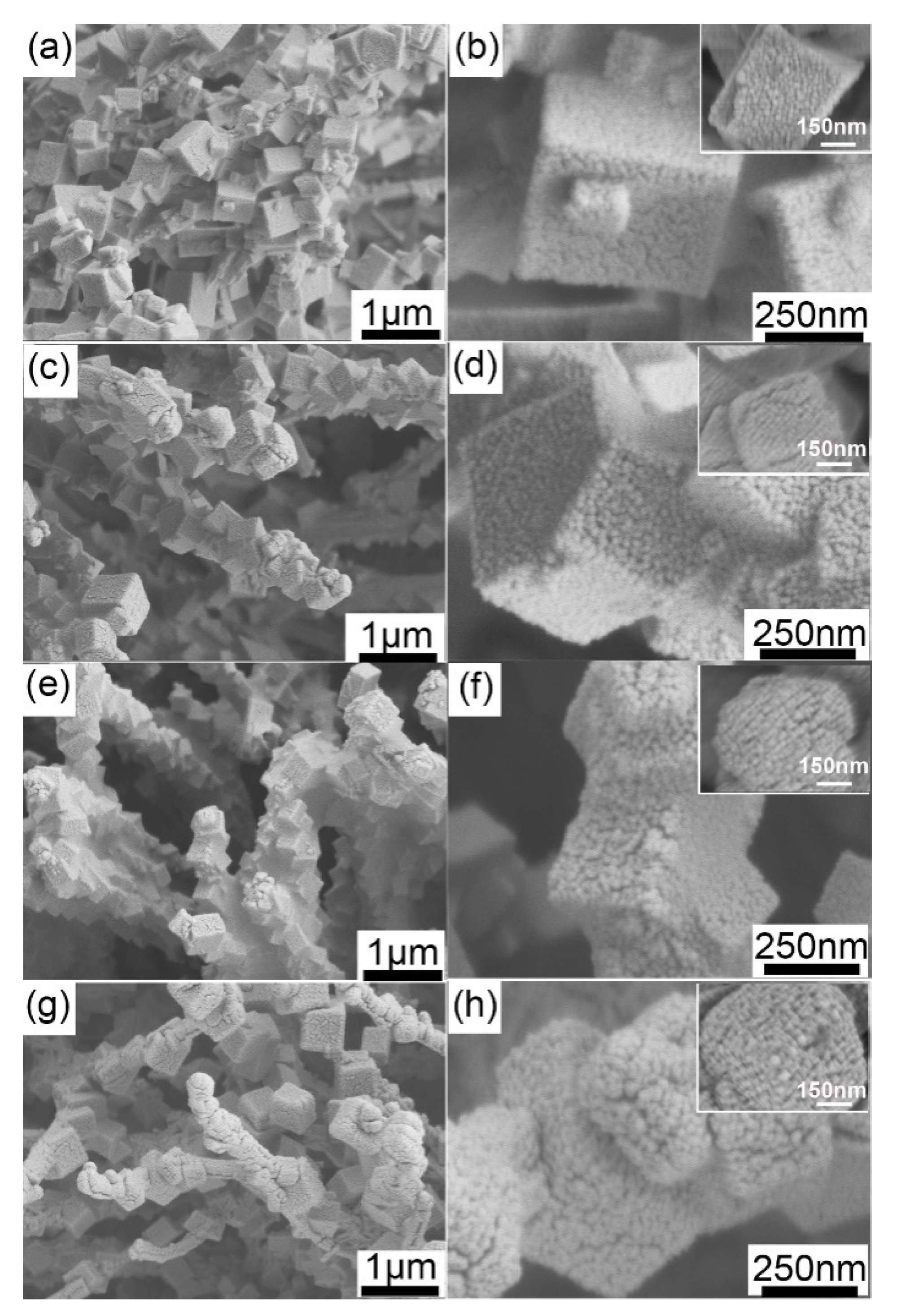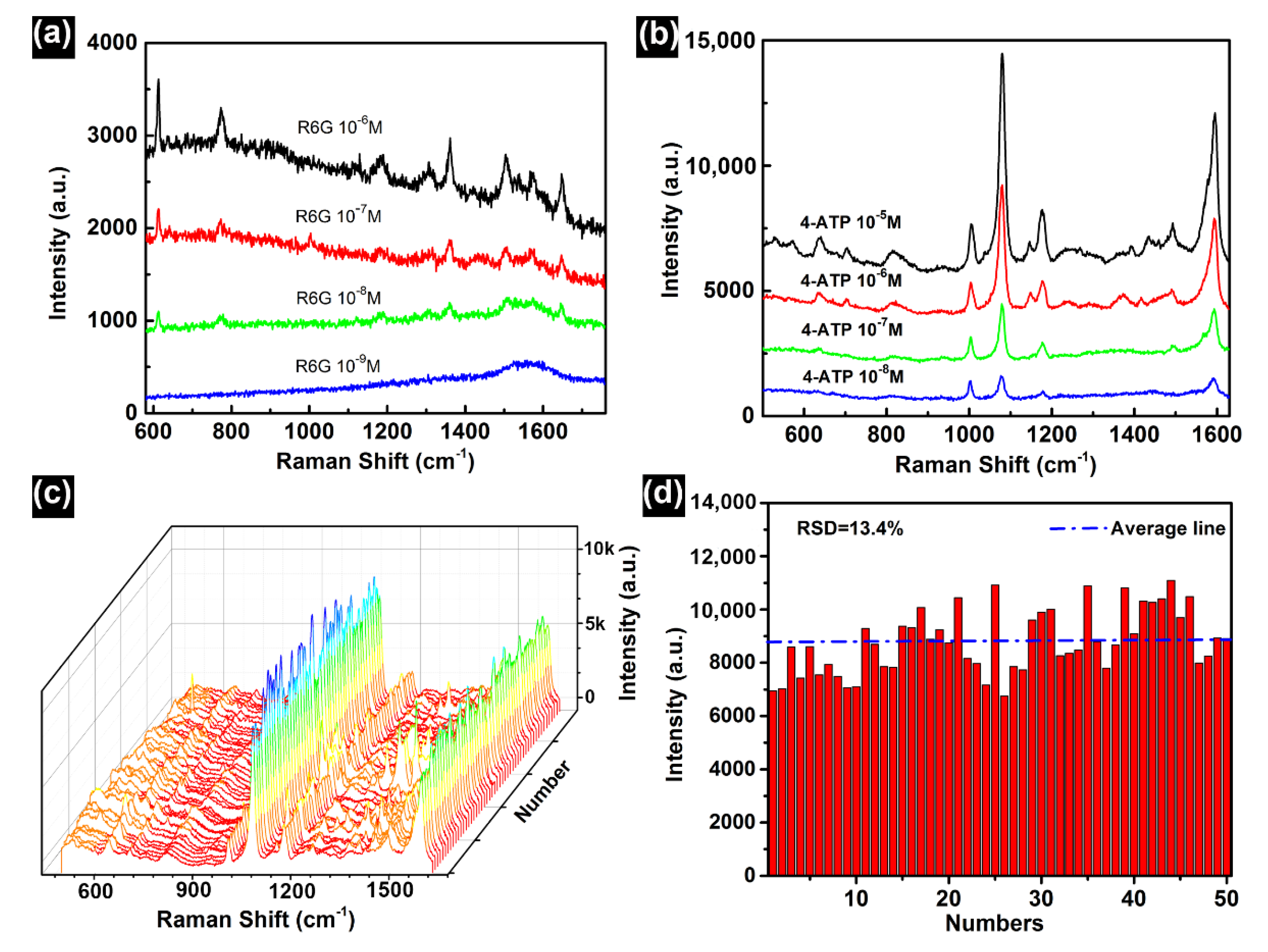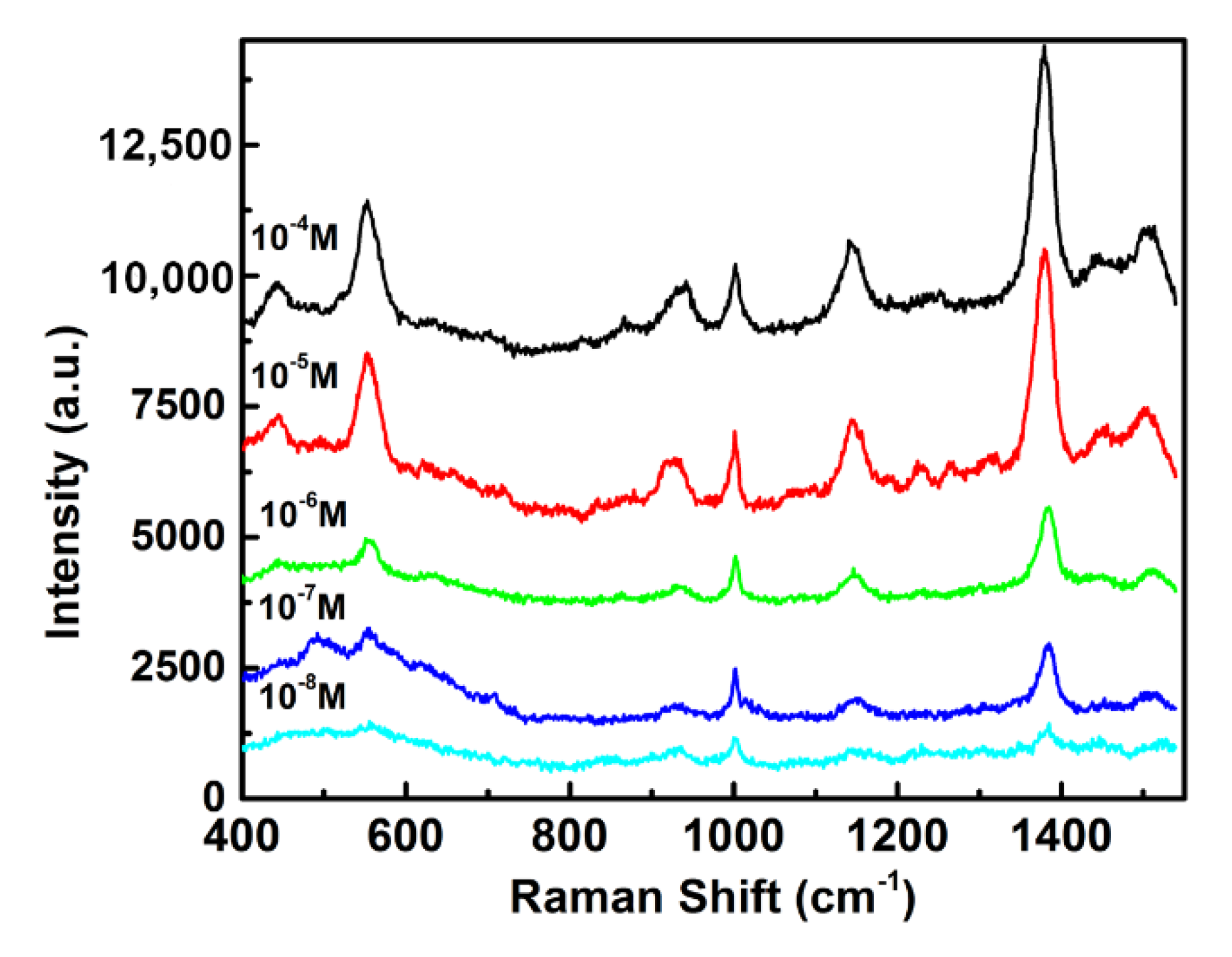Fabrication of Au-Nanoparticle-Decorated Cu Mesh/Cu(OH)2@HKUST-1 Nanorod Arrays and Their Applications in Surface-Enhanced Raman Scattering
Abstract
:1. Introduction
2. Materials and Methods
2.1. Chemicals
2.2. Pretreatment of Cu Mesh
2.3. Preparation of Cu(OH)2 Nanorods
2.4. Preparation of Cu(OH)2@HKUST-1 Nanorods
2.5. Preparation of CuO Nanorods
2.6. Sputtering Au NPs onto the Different Arrays on the Cu Mesh
2.7. Characterizations
2.8. SERS Measurements
3. Results and Discussion
4. Conclusions
Supplementary Materials
Author Contributions
Funding
Data Availability Statement
Conflicts of Interest
References
- Fleischmann, M.; Hendra, P.J.; McQuillan, A.J. Raman spectra of pyridine adsorbed at a silver electrode. Chem. Phys. Lett. 1974, 26, 163–166. [Google Scholar] [CrossRef]
- Cao, W.Y.C.; Jin, R.; Mirkin, C.A. Nanoparticles with Raman Spectroscopic Fingerprints for DNA and RNA Detection. Science 2002, 297, 1536. [Google Scholar] [CrossRef] [PubMed] [Green Version]
- Zheng, P.; Shi, X.; Curtin, K.; Yang, F.; Wu, N. Detection of mercury(II) with a surface-enhanced Raman scattering sensor based on functionalized gold nanoparticles. Mater. Res. Express. 2017, 4, 055017. [Google Scholar] [CrossRef]
- Tezcan, T.; Hsu, C.-H. High-sensitivity SERS based sensing on the labeling side of glass slides using low branched gold nanoparticles prepared with surfactant-free synthesis. RSC Adv. 2020, 10, 34290–34298. [Google Scholar] [CrossRef]
- Neng, J.; Zhang, Q.; Sun, P. Application of surface-enhanced Raman spectroscopy in fast detection of toxic and harmful substances in food. Biosens. Bioelectron. 2020, 167, 112480. [Google Scholar] [CrossRef] [PubMed]
- Qu, L.L.; Ying, Y.L.; Yu, R.J.; Long, Y.T. In situ food-borne pathogen sensors in a nanoconfined space by surface enhanced Raman scattering. Microchim. Acta 2021, 188, 201. [Google Scholar] [CrossRef]
- Liu, Y.; Li, X.; Cheng, J.; Zhou, N.; Zhang, L.; Mao, H.; Huang, C. SERS devices with “hedgehog-like” nanosphere arrays for detection of trace pesticides. J. Innov. Opt. Health Sci. 2021, 14, 2141005. [Google Scholar] [CrossRef]
- Chen, L.; Liu, W.; Shen, D.; Liu, Y.; Zhou, Z.; Liang, X.; Wan, W. All-optical tunable plasmonic nano-aggregations for surface-enhanced Raman scattering. Nanoscale 2019, 11, 13558–13566. [Google Scholar] [CrossRef] [PubMed]
- Peng, Y.; Lin, C.; Long, L.; Masaki, T.; Tang, M.; Yang, L.; Liu, J.; Huang, Z.; Li, Z.; Luo, X.; et al. Charge-Transfer Resonance and Electromagnetic Enhancement Synergistically Enabling MXenes with Excellent SERS Sensitivity for SARS-CoV-2 S Protein Detection. Nano-Micro Lett. 2021, 13, 52. [Google Scholar] [CrossRef]
- Xiao, T.-H.; Cheng, Z.; Luo, Z.; Isozaki, A.; Hiramatsu, K.; Itoh, T.; Nomura, M.; Iwamoto, S.; Goda, K. All-dielectric chiral-field-enhanced Raman optical activity. Nat. Commun. 2021, 12, 3062. [Google Scholar] [CrossRef]
- Kim, N.H.; Hwang, W.; Baek, K.; Rohman, M.R.; Kim, J.; Kim, H.W.; Mun, J.; Lee, S.Y.; Yun, G.; Murray, J.; et al. Smart SERS Hot Spots: Single Molecules Can Be Positioned in a Plasmonic Nanojunction Using Host-Guest Chemistry. J. Am. Chem. Soc. 2018, 140, 4705–4711. [Google Scholar] [CrossRef]
- Markina, N.E.; Ustinov, S.N.; Zakharevich, A.M.; Markin, A.V. Copper nanoparticles for SERS-based determination of some cephalosporin antibiotics in spiked human urine. Anal. Chim. Acta 2020, 1138, 9–17. [Google Scholar] [CrossRef] [PubMed]
- Liu, Y.; Lei, L.; Wu, Y.; Chen, Y.; Yan, J.; Zhu, W.; Tan, X.; Wang, Q. Fabrication of sea urchin-like Au@SiO2 nanoparticles SERS substrate for the determination of malachite green in tilapia. Vib. Spectrosc. 2021, 118, 103319. [Google Scholar] [CrossRef]
- Xie, B.; Wang, Z.-P.; Zhang, R.; Zhang, Z.; He, Y. A SERS aptasensor based on porous Au-NC nanoballoons for Staphylococcus aureus detection. Anal. Chim. Acta 2022, 1190, 339175. [Google Scholar] [CrossRef] [PubMed]
- Alvarez-Puebla, R.; Cui, B.; Bravo-Vasquez, J.-P.; Veres, T.; Fenniri, H. Nanoimprinted SERS-Active Substrates with Tunable Surface Plasmon Resonances. J. Phys. Chem. C 2007, 111, 6720–6723. [Google Scholar] [CrossRef]
- Endo, T.; Yamada, H.; Yamada, K. Template Stripping Method-Based Au Nanoarray for Surface-Enhanced Raman Scattering Detection of Antiepileptic Drug. Micromachines 2020, 11, 936. [Google Scholar] [CrossRef]
- Chen, X.; Liang, M.-M.; Xu, J.; Sun, H.-L.; Wang, C.; Wei, J.; Zhang, H.; Yang, W.-M.; Yang, Z.-L.; Sun, J.-J.; et al. Unveiling the size effect of Pt-on-Au nanostructures on CO and methanol electrooxidation by in situ electrochemical SERS. Nanoscale 2020, 12, 5341–5346. [Google Scholar] [CrossRef]
- Kneipp, K.; Wang, Y.; Kneipp, H.; Perelman, L.T.; Itzkan, I.; Dasari, R.R.; Feld, M.S. Single Molecule Detection Using Surface-Enhanced Raman Scattering (SERS). Phys. Rev. Lett. 1997, 78, 1667–1670. [Google Scholar] [CrossRef] [Green Version]
- Lee, H.K.; Lee, Y.H.; Koh, C.S.L.; Phan-Quang, G.C.; Han, X.; Lay, C.L.; Sim, H.Y.F.; Kao, Y.C.; An, Q.; Ling, X.Y. Designing surface-enhanced Raman scattering (SERS) platforms beyond hotspot engineering: Emerging opportunities in analyte manipulations and hybrid materials. Chem. Soc. Rev. 2019, 48, 731–756. [Google Scholar] [CrossRef]
- Zhao, F.; Wang, X.; Zhang, Y.; Lu, X.; Xie, H.; Xu, B.; Ye, W.; Ni, W. In situ monitoring of silver adsorption on assembled gold nanorods by surface-enhanced Raman scattering. Nanotechnology 2020, 31, 295601. [Google Scholar] [CrossRef]
- Zhang, H.; Wang, J.; Li, G.; Chen, L.; Wang, H.; Tian, X. Fabrication of Ag-nanosheet-assembled hollow tubular array and their SERS effect. J. Less-Common Met. 2019, 772, 663–668. [Google Scholar] [CrossRef]
- Hu, B.; Sun, D.-W.; Pu, H.; Wei, Q. A dynamically optical and highly stable pNIPAM@Au NRs nanohybrid substrate for sensitive SERS detection of malachite green in fish fillet. Talanta 2020, 218, 121188. [Google Scholar] [CrossRef]
- Hu, W.; Xia, L.; Hu, Y.; Li, G. Recent progress on three-dimensional substrates for surface-enhanced Raman spectroscopic analysis. Microchem. J. 2022, 172, 106908. [Google Scholar] [CrossRef]
- Ostovar, B.; Cai, Y.Y.; Tauzin, L.J.; Lee, S.A.; Ahmadivand, A.; Zhang, R.; Nordlander, P.; Link, S. Increased Intraband Transitions in Smaller Gold Nanorods Enhance Light Emission. ACS Nano 2020, 14, 15757–15765. [Google Scholar] [CrossRef]
- Zhang, L.; Weng, Y.-j.; Liu, X.; Gu, W.; Zhang, X.; Han, L. Fe(III) Mixed IP6@Au NPs with Enhanced SERS Activity for Detection of 4-ATP. Sci. Rep. 2020, 10, 5752. [Google Scholar] [CrossRef] [PubMed] [Green Version]
- Yilmaz, M.; Erkartal, M.; Ozdemir, M.; Sen, U.; Usta, H.; Demirel, G. Three-Dimensional Au-Coated Electrosprayed Nanostructured BODIPY Films on Aluminum Foil as Surface-Enhanced Raman Scattering Platforms and Their Catalytic Applications. ACS Appl. Mater. Interfaces 2017, 9, 18199–18206. [Google Scholar] [CrossRef]
- Guo, L.; Cao, H.; Cao, L.; Li, N.; Zhang, A.; Shang, Z.; Jiao, T.; Liu, H.L.; Wang, M. Improve optical properties by modifying Ag nanoparticles on a razor clam SERS substrate. Opt. Express 2021, 29, 5152–5165. [Google Scholar] [CrossRef]
- Ma, X.; Wang, W.; Sun, C.; Li, H.; Sun, J.; Liu, X. Adsorption performance and kinetic study of hierarchical porous Fe-based MOFs for toluene removal. Sci. Total Environ. 2021, 793, 148622. [Google Scholar] [CrossRef]
- Huang, Z.; Meng, G.; Hu, X.; Pan, Q.; Huo, D.; Zhou, H.; Ke, Y.; Wu, N. Plasmon-tunable Au@Ag core-shell spiky nanoparticles for surface-enhanced Raman scattering. Nano Res. 2019, 12, 449–455. [Google Scholar] [CrossRef]
- Si, S.; Liang, W.; Sun, Y.; Huang, J.; Ma, W.; Liang, Z.; Bao, Q.; Jiang, L. Facile Fabrication of High-Density Sub-1-nm Gaps from Au Nanoparticle Monolayers as Reproducible SERS Substrates. Adv. Funct. Mater. 2016, 26, 8137–8145. [Google Scholar] [CrossRef]
- Maity, A.; Samanta, S.; Biswas, D.; Chakravorty, D. Studies on nanoconfinement effect of NiO-SiO2 spin glass within mesoporous Al2O3 template. J. Alloys Compd. 2021, 887, 161447. [Google Scholar] [CrossRef]
- Li, Y.; Yang, S.; Lu, X.; Duan, W.; Moriga, T. Synthesis and evaluation of the SERS effect of Fe3O4–Ag Janus composite materials for separable, highly sensitive substrates. RSC Adv. 2019, 9, 2877–2884. [Google Scholar] [CrossRef] [Green Version]
- Wang, X.; Shi, W.; Wang, S.; Zhao, H.; Lin, J.; Yang, Z.; Chen, M.; Guo, L. Two-Dimensional Amorphous TiO2 Nanosheets Enabling High-Efficiency Photoinduced Charge Transfer for Excellent SERS Activity. J. Am. Chem. Soc. 2019, 141, 5856–5862. [Google Scholar] [CrossRef]
- Wang, X.; Zhu, J.; Wu, Y.; Xu, Y.; Su, Y.; Zhang, L.; Qi, Y.; Wen, X.; Yang, H. Hybrid surface plasmon effect and SERS characterization in a heterogeneous composite structure of Au nano-array and Ag film. Results Phys. 2020, 17, 103175. [Google Scholar] [CrossRef]
- Pal, S.; Bhunia, A.; Jana, P.P.; Dey, S.; Möllmer, J.; Janiak, C.; Nayek, H.P. Microporous La–Metal–Organic Framework (MOF) with Large Surface Area. Chem.-Eur. J. 2015, 21, 2789–2792. [Google Scholar] [CrossRef]
- Li, X.; Mao, Y.; Leng, K.; Ye, G.; Sun, Y.; Xu, W. Synthesis of amino-functionalized MIL-101(Cr) with large surface area. Mater. Lett. 2017, 197, 192–195. [Google Scholar] [CrossRef]
- Phan-Quang, G.C.; Yang, N.; Lee, H.K.; Sim, H.Y.F.; Koh, C.S.L.; Kao, Y.-C.; Wong, Z.C.; Tan, E.K.M.; Miao, Y.-E.; Fan, W.; et al. Tracking Airborne Molecules from Afar: Three-Dimensional Metal–Organic Framework-Surface-Enhanced Raman Scattering Platform for Stand-Off and Real-Time Atmospheric Monitoring. ACS Nano 2019, 13, 12090–12099. [Google Scholar] [CrossRef]
- Lafuente, M.; De Marchi, S.; Urbiztondo, M.; Pastoriza-Santos, I.; Pérez-Juste, I.; Santamaría, J.; Mallada, R.; Pina, M. Plasmonic MOF Thin Films with Raman Internal Standard for Fast and Ultrasensitive SERS Detection of Chemical Warfare Agents in Ambient Air. ACS Sens. 2021, 6, 2241–2251. [Google Scholar] [CrossRef] [PubMed]
- Chandra, S.; Kumar, A.; Tomar, P.K. Synthesis and characterization of copper nanoparticles by reducing agent. J. Saudi Chem. Soc. 2014, 18, 149–153. [Google Scholar] [CrossRef] [Green Version]
- Peng, C.-Y.; Hou, C.-C.; Chen, Q.-Q.; Wang, C.-J.; Lv, X.-J.; Zhong, J.; Fu, W.-F.; Che, C.-M.; Chen, Y. Cu(OH)2 supported on Fe(OH)3 as a synergistic and highly efficient system for the dehydrogenation of ammonia-borane. Sci. Bull. 2018, 63, 1583–1590. [Google Scholar] [CrossRef] [Green Version]
- Lin, K.-S.; Adhikari, A.K.; Ku, C.-N.; Chiang, C.-L.; Kuo, H. Synthesis and characterization of porous HKUST-1 metal organic frameworks for hydrogen storage. Int. J. Hydrog. Energy 2012, 37, 13865–13871. [Google Scholar] [CrossRef]
- Liu, Y.; Huang, Z.; Zhou, F.; Lei, X.; Yao, B.; Meng, G.; Mao, Q. Highly sensitive fibre surface-enhanced Raman scattering probes fabricated using laser-induced self-assembly in a meniscus. Nanoscale 2016, 8, 10607–10614. [Google Scholar] [CrossRef] [PubMed]
- Zhu, Q.; Li, Y.; Wang, W.; Sun, G.; Yan, K.; Wang, D. High performance HKUST-1@PVA-co-PE/PVA hybrid hydrogel with enhanced selective adsorption. Compos. Commun. 2018, 10, 36–40. [Google Scholar] [CrossRef]
- Wu, C.; Chen, E.; Wei, J. Surface enhanced Raman spectroscopy of Rhodamine 6G on agglomerates of different-sized silver truncated nanotriangles. Colloids Surf. A 2016, 506, 450–456. [Google Scholar] [CrossRef] [Green Version]
- Yuan, C.; Liu, R.; Wang, S.; Han, G.; Han, M.-Y.; Jiang, C.; Zhang, Z. Single clusters of self-assembled silver nanoparticles for surface-enhanced Raman scattering sensing of a dithiocarbamate fungicide. J. Mater. Chem. 2011, 21, 16264–16270. [Google Scholar] [CrossRef]
- Saute, B.; Narayanan, R. Solution-based direct readout surface enhanced Raman spectroscopic (SERS) detection of ultra-low levels of thiram with dogbone shaped gold nanoparticles. Analyst 2011, 136, 527–532. [Google Scholar] [CrossRef] [PubMed]
- Chen, M.; Liu, D.; Du, X.; Lo, K.H.; Wang, S.; Zhou, B.; Pan, H. 2D materials: Excellent substrates for surface-enhanced Raman scattering (SERS) in chemical sensing and biosensing. TrAC Trends Anal. Chem. 2020, 130, 115983. [Google Scholar] [CrossRef]







Publisher’s Note: MDPI stays neutral with regard to jurisdictional claims in published maps and institutional affiliations. |
© 2021 by the authors. Licensee MDPI, Basel, Switzerland. This article is an open access article distributed under the terms and conditions of the Creative Commons Attribution (CC BY) license (https://creativecommons.org/licenses/by/4.0/).
Share and Cite
Huang, X.; Cai, L.; Fan, T.; Sun, K.; Yao, L.; Zhang, L.; Li, Z. Fabrication of Au-Nanoparticle-Decorated Cu Mesh/Cu(OH)2@HKUST-1 Nanorod Arrays and Their Applications in Surface-Enhanced Raman Scattering. Sustainability 2022, 14, 228. https://doi.org/10.3390/su14010228
Huang X, Cai L, Fan T, Sun K, Yao L, Zhang L, Li Z. Fabrication of Au-Nanoparticle-Decorated Cu Mesh/Cu(OH)2@HKUST-1 Nanorod Arrays and Their Applications in Surface-Enhanced Raman Scattering. Sustainability. 2022; 14(1):228. https://doi.org/10.3390/su14010228
Chicago/Turabian StyleHuang, Xiaoqiao, Li Cai, Tingting Fan, Kexi Sun, Le Yao, Lijun Zhang, and Zhongbo Li. 2022. "Fabrication of Au-Nanoparticle-Decorated Cu Mesh/Cu(OH)2@HKUST-1 Nanorod Arrays and Their Applications in Surface-Enhanced Raman Scattering" Sustainability 14, no. 1: 228. https://doi.org/10.3390/su14010228





